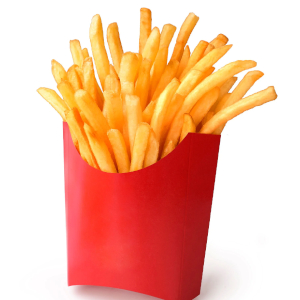And it’s inevitable. And the change from humans to machines for prep and service is coming upon customers with blinding rapidity. Alas for employees, Fast Food resto operators just can’t afford to pay humans any longer.
 Chippy the Deep-Frying Robot: Just one of the Fast Food-specific kitchen robots
Chippy the Deep-Frying Robot: Just one of the Fast Food-specific kitchen robots
from Miso Robotics. More than 1.637 million baskets already fried…
Meet Chippy, Hyphen and Autocado
They’re a trio of specialized robots that are going to revolutionize Chipotle’s production and service systems. And replace a whole bunch of human employees. But we’ll tackle that angle later.
“We are always exploring opportunities to enhance our employee and guest experience. Our goal is to drive efficiencies through collaborative robotics that will enable Chipotle’s crew members to focus on other tasks in the restaurant,” said Curt Garner, the chain’s Chief Technology Officer.
Chippy is designed to do one thing and do it well. It cooks and seasons Chipotle’s signature tortilla chips.
Autocado is a slightly more complex automaton that prepares Chipotle’s signature Guacamole dip, untouched by human hands.
Hyphen is also a precisely-targeted mechanism: “Hyphen is being tuned to craft perfectly portioned burrito bowls and salads along an automated makeline, while a human crew member makes burritos, tacos, and quesadillas above the line,” a Chipotle Instagram post tells us.
Other chains are also on the automation bandwagon. White Castle has committed to install Chippy deep-frying robots in 100 of its busiest locations. McDonald’s and other chains began installing interactive digital ordering systems in their restos ages ago, making counter staff redundant.
Virtually all the major chains will employ some level of automation in their next-gen restos. They’re starting to roll off the drawing board and onto downsized real estate footptints as we speak. And we’re told the conversion of almost all Fast Food restos to the new business model will be complete by 2030.
What automation can and can’t do
Automated systems can take your order digitally, whether at a drive-thru window, through your phone or via a delivery service. They can prepare certain food items, assemble multi-item orders and pack them for hand-off to delivery drivers or drive-through customers.
What they can’t do is fix themselves when they break down, or refill their own ingredient hoppers.
And most important from the customer’s point of view: They can’t answer your questions or address your complaints.
So it looks as though there will always be a place for a minimum few humans in the loop.
Robots cost far less than humans
One reason fast Food operators want to automate is, of course, to get humans out of the system as much as possible. Humans are error-prone by nature, distractable and prey to fatigue. You don’t have to worry about those factors with machines.
In addition – and this is a big advantage of machines – is they don’t need wages, benefits, income tax bookkeeping or days off.
Perhaps most important to Fast Food operators is, they can keep the main component of their cost picture under control. That, of course, is wages. Most North American jurisdictions now mandate a minimum wage of anywhere from $12 to $15 an hour. It’s a back-breaker for many operators. And it’s a pivotal reason Fast Food menu prices have soared in the post-COVID era. That, and the skyrocketing cost of food.
Customers forced to use ‘the app’
If you’ve been wondering why virtually all the fast food joints, large and small, are tying their rolling specials and deals to ‘order by app only’ rules… That’s all part of the master plan. The more customers they can habituate to ordering and paying remotely, and using delivery services, the fewer they have to accommodate on site. Ideally, they’d like to phase out their in-store dining rooms all together. Another big savings ‘opportunity’.
My take
I’ve been spotlighting all the above measures when they come up in the course of in my daily posts. But taken together in one post, like this, they represent a tsunami-like wave of change washing over the Fast Food sector.
Are we prepared to go along with the ‘improvements’? I think those of us who are old enough to have experienced the ‘old way’ and are firmly set in our expectations will be turned off. It may take another generation or two before the new automated Fast Food business model is accepted by the majority of its users as the norm.
~ Maggie J.

